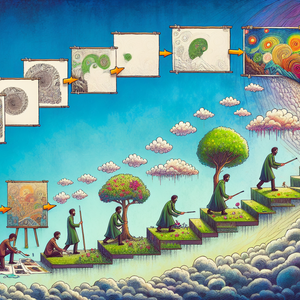Exploring the Emotional Depths of Inside Out 2

One of the most significant transitions in a person's life occurs during adolescence, a time marked by profound emotional shifts and self-discovery. "Inside Out 2" is poised to capture this transformative phase as Riley navigates the challenges of her teenage years. The first film introduced viewers to five core emotions: Joy, Sadness, Anger, Fear, and Disgust. However, as Riley matures, it is likely that she will encounter a broader spectrum of feelings—such as anxiety, embarrassment, and even newfound excitement—that reflect the more complex reality of adolescence. This period is characterized by a myriad of experiences that can be both exhilarating and overwhelming. As Riley grapples with her identity and the pressures of social acceptance, the film is expected to highlight the emotional rollercoaster that accompanies this pivotal time in her life.
Introducing New Emotions
The original "Inside Out" effectively illustrated how emotions interact and influence behavior. In "Inside Out 2," we can expect the introduction of new emotions that may arise from Riley's experiences as a teenager. For example, emotions like Anxiety could be personified as a character who represents the pressure of social expectations and academic performance. This character might embody the constant worry that many teenagers face regarding their place in the world. Similarly, a character representing Embarrassment could navigate the awkwardness of teenage interactions, providing a fresh perspective on the often tumultuous social landscape of high school. These new emotions will enrich the narrative by offering a nuanced portrayal of the challenges of adolescence, encouraging viewers to embrace the complexity of their own feelings.
Emotional Conflict and Resilience
As Riley faces the ups and downs of adolescence, the emotional conflict is likely to intensify. The sequel may explore themes of resilience, highlighting how Riley learns to manage her emotions and cope with challenges. For instance, a pivotal moment could involve Riley experiencing a significant setback—perhaps related to friendships or romantic interests—that forces her to confront feelings of disappointment and inadequacy. Through this journey, the film can illustrate the importance of acknowledging and processing negative emotions as a vital part of personal growth. Rather than simply promoting the idea that happiness should be the ultimate goal, "Inside Out 2" could emphasize that experiencing a range of emotions, including sadness and frustration, is essential for developing resilience and understanding oneself.
The Role of Relationships
Another critical aspect of Riley's emotional journey in "Inside Out 2" will be her relationships with family and friends. The dynamics of these relationships can significantly impact a teenager's emotional well-being. The sequel may delve into how Riley's interactions with her parents evolve, particularly as she seeks independence while still grappling with the need for support and understanding. The film could poignantly depict the struggle between the desire for autonomy and the comfort of familial bonds, showcasing how Riley's parents navigate their own emotions as they witness their daughter growing up. Additionally, the film may showcase the importance of friendships, exploring how peer relationships can serve as both a source of joy and a source of anxiety during the teenage years. These interactions can evoke a spectrum of emotions, from camaraderie to rivalry, thereby enriching the narrative and making it relatable to a wider audience.
"Inside Out 2" holds the potential to be a groundbreaking exploration of the emotional complexities that accompany the transition from childhood to adolescence. By introducing new emotions, highlighting the struggle for resilience, and examining the significance of relationships, the sequel promises to resonate deeply with audiences. Just as the first film offered valuable insights into the emotional lives of children, "Inside Out 2" has the opportunity to provide a meaningful commentary on the challenges of growing up. As viewers prepare to join Riley on this new journey, they can expect not only to laugh and cry but also to reflect on their own emotional experiences during one of life's most defining phases. The film stands to remind us that emotions are not just fleeting feelings but integral parts of our humanity that contribute to our growth and understanding of the world around us. With its anticipated release, "Inside Out 2" is set to become a poignant exploration of the teenage experience, offering wisdom and comfort to audiences of all ages.
Child Psychologist
Hospitals, private practices, schools, and mental health clinics
Core Responsibilities
Assess and diagnose emotional and behavioral issues in children and adolescents.
Develop and implement treatment plans tailored to the individual needs of clients.
Collaborate with families and schools to provide comprehensive support.
Required Skills
Strong understanding of child development and psychological theories.
Excellent communication skills to engage with children and parents effectively.
Ability to conduct therapy sessions in an empathetic and supportive manner.
Animation Storyboard Artist
Animation studios such as Pixar, DreamWorks, and independent film companies
Core Responsibilities
Create detailed storyboards that visually represent scenes and character emotions in animated films.
Collaborate with directors and writers to translate scripts into visual narratives.
Revise storyboards based on feedback to ensure the emotional depth aligns with the film's vision.
Required Skills
Proficient in drawing, illustration, and digital animation software (e.g., Adobe Creative Suite).
Strong storytelling skills, particularly in conveying complex emotions visually.
Understanding of pacing, composition, and visual continuity in animation.
Youth Counselor
Community centers, schools, and non-profit organizations focused on youth development
Core Responsibilities
Provide guidance and support to teenagers facing emotional and social challenges.
Facilitate group discussions and activities to promote self-awareness and emotional intelligence.
Develop programs and workshops that address issues such as anxiety, self-esteem, and peer relationships.
Required Skills
Strong interpersonal skills and the ability to connect with adolescents.
Knowledge of developmental psychology and techniques for managing conflict.
Experience in crisis intervention and conflict resolution.
Emotional Intelligence Training Facilitator
Corporate training firms, educational institutions, and consulting agencies
Core Responsibilities
Design and deliver training programs focused on enhancing emotional intelligence in individuals and teams.
Conduct workshops that teach skills such as empathy, self-regulation, and interpersonal communication.
Evaluate participant progress and provide feedback to facilitate personal and professional growth.
Required Skills
Strong background in psychology, coaching, or organizational behavior.
Excellent presentation and public speaking skills.
Ability to create engaging and interactive learning experiences.
Film and Media Psychologist
Film production companies, academic institutions, and consulting firms specializing in media analysis
Core Responsibilities
Analyze and consult on the psychological accuracy of character development and emotional portrayal in films and media.
Collaborate with writers and directors to ensure authentic representation of psychological concepts.
Conduct workshops and discussions about the impact of media on emotional development and societal perceptions.
Required Skills
Expertise in psychology, particularly developmental and media psychology.
Strong analytical skills to assess scripts and character arcs critically.
Ability to communicate complex psychological concepts to non-specialists.


